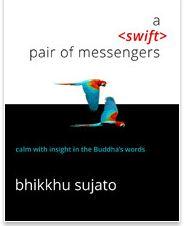
A swift pair of messengers by Bhikkhu Sujato aims to clarify the meaning and function of samatha and vipassana in Buddhist meditation. Much has been written on this topic, yet confusion persists. Time and again the suttas indicate that key aspects of vipassana, especially impermanence, must be understood in terms of dependent origination – how the identification and involvement with experience projects consciousness into future rebirth. Dependent origination is the thread which ties this work together. Download it here (160 pages/1.4MB):
 A Swift Pair of Messengers
A Swift Pair of Messengers
You can buy the print version here: Link
Impermanence in Buddhism: A Deep Dive
Impermanence, or anicca as it is known in Pali, is a foundational concept in Buddhism. It refers to the idea that all things, including the self, are transient and ever-changing. Understanding and truly realizing the nature of impermanence can provide insight into the heart of existence and lead one towards enlightenment.
Historical Background
After attaining enlightenment under the Bodhi tree, the Buddha proclaimed the Four Noble Truths. The first is the truth of suffering (dukkha), and impermanence is closely tied to this concept. He observed that everything in the material and mental universe is subject to change and that clinging to or resisting this intrinsic feature of existence leads to suffering.
The Nature of Impermanence
There are several layers to the Buddhist understanding of impermanence:
- Physical Impermanence: This is the most evident form of impermanence. All around us, we can see things change and decay. Nothing stays the same indefinitely from the wilting of a flower to the erosion of a mountain.
- Mental Impermanence: Our emotions, thoughts, and perceptions are constantly changing. A momentary feeling of joy can quickly change into sadness, and vice versa. Our beliefs and views may evolve over time as well.
- Universal Impermanence: On a larger scale, societies, cultures, and even civilizations rise and fall. Scientific studies have shown that entire galaxies and stars undergo a lifecycle. From birth to death, everything is in a state of flux.
The Illusion of Permanence
Humans naturally seek stability. For our ancestors, recognizing patterns and predicting outcomes was a matter of survival. However, this evolutionary advantage also brought about the delusion of permanence.
In modern life, this manifests in various ways. We cling to youthful beauty, pursue lasting happiness in material possessions, or seek immortality through fame or offspring. But time eventually takes all things, leading to the inevitable sufferings of aging, loss, and death.
Impermanence and the Self
Anicca is closely tied to the concept of anatta or no-self. If everything is impermanent, then the idea of a constant, unchanging self is a delusion. Our physical body changes, our thoughts shift, and our feelings are in constant flux. Thus, clinging to a sense of an unchanging identity can lead to suffering.
Embracing Impermanence
Realizing impermanence can be liberating. By accepting the transient nature of all things:
- We appreciate the present: Recognizing that all experiences are fleeting makes us more present in each moment.
- We let go more easily: Understanding that change is inevitable helps in letting go of past regrets and fears of future uncertainties.
- We find lasting happiness: Instead of seeking joy in the impermanent, we find it in the timeless, such as in love, compassion, and self-awareness.
Impermanence in Meditation
Mindfulness meditation often focuses on the impermanent nature of existence. Meditators are guided to observe the coming and going of their thoughts, the changing sensations in their bodies, and the ebb and flow of their emotions. Over time, this practice can lead to a profound understanding of anicca.
Conclusion
Impermanence is not a pessimistic view of the world but a realistic one. By understanding and embracing it, we free ourselves from many of the sources of suffering. As the Buddha said, understanding the nature of things is the path to enlightenment, and in this understanding, we find our freedom.

